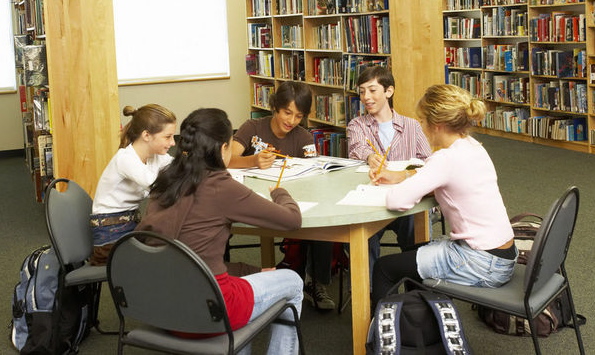 The final posts in our anti-bullying series take us into two unique learning settings: a middle school special needs class and an alternative high school. Our special needs story will be presented first, with the alternative classroom in a separate post. We’ve selected these environments to shine light on classrooms that experience bullying on a different level than their mainstream counterparts.
The final posts in our anti-bullying series take us into two unique learning settings: a middle school special needs class and an alternative high school. Our special needs story will be presented first, with the alternative classroom in a separate post. We’ve selected these environments to shine light on classrooms that experience bullying on a different level than their mainstream counterparts.
A Special Needs Class: Middle/High School
This classroom perspective comes to you from abcteach staff member and retired specialist, Janie Quinn. Janie taught moderate cognitively-impaired and autistic spectrum students for over 30 years, with most of her experience in the middle and high school settings.
Austism Spectrum Disorders (ASD)
Being a special needs teacher, many of the students I worked with were prime suspects for bullying. Across the board, our approach was always to handle situations proactively. When we knew one of our kids was being placed in a class where their peers were not familiar with ASD, we did an educational intervention. During these events, one or more staff members would present general information about Autism, along with examples of the many “quirks” our students could exhibit. We tried to explain the background of ASD and why the students’ autistic classmates may act/respond in a certain way.
Normally, a special needs teacher or assistant was frequently in class with an ASD student. If things seemed to be getting dicey, the staff member would often ask for 5 minutes at the beginning or end of class to do a brainstorming session. They would propose a hypothetical situation similar to what they were observing, e.g., a student in one of your classes is making odd noises or comments during class. Why do you think they are doing this? How can we help them control this and be more appropriate? Even in middle school you would be amazed at how perceptive students are. Having a better understanding of why something is happening and how they may be able to help often leads to a better experience for all.
Students generally have lots of questions and often ask about situations in other classes. We stressed to them that we are working together in an adult fashion, and spoke about the importance of confidentiality. Laughing, inappropriate behavior, or comments are handled by letting everybody know they are not “adult-like” responses, and are not helping the situation.
ASD and Cognitively Impaired (CI)
In the ASD and CI classrooms (CI is the old “mentally retarded”), our main goal was self advocacy. The underlying theme in that approach is that everyone is different and unique. Students learned about their individual strengths and areas that needed improvement, while at the same time, were taught that everybody has different capabilities. We reinforced that it was ok not to be the best in everything, and that patience was needed when others didn’t perform as well as they did.
The following are a handful of activities that we used with our students:
• Create a “Script” – these were for students to say if confronted with a stressful situation.
• Role Play – this was mostly done with special needs students. I used many social situation scenarios and had my students role play to help them practice and comprehend the nuances of social interactions.
• Focusing on Strengths – Most of the ASD kids who were capable of progressing in the general ed classes were happy about being with their peers in a more academically challenging environment. These children generally see only the black or white of a situation – for them, there are no gray areas! Life unfortunately does have gray areas, so this is where we focused a lot on their strengths..
• Example – A student was in a general 7th grade math class. In order to be successful, he attended class and got backup instruction in special ed. He wanted to be part of his class, but socially he was a few years behind. One of his strengths was somehow knowing what day a date fell on – no matter what the year. He was amazing! He would ask when you were born, and then give the date, including the year, or would say “Oh, you were born on a Monday!” As far as I could tell, he was always right! We used this strength during the first few weeks of class, trying to get other students to perform the skill, then asking him. His peers were really impressed and afterwards were much more inclusive with him. They frequently asked about his “talent” or had him show off to their friends. After this, the peers were much kinder and more helpful when the student struggled or acted differently.
• Problem Solving Strategies – Students were taught a number of strategies so that they could identify what worked best for them. These strategies included walking away from a conflict, finding a friendly group to go to, walking to an area where an adult was present, etc.
• Secure Classrooms – an important component of working with these kids was to create an environment where they felt safe. We talked about the class being a “family,” and that we needed to look after each other. If they witnessed bullying, they needed to notify an adult. We stressed that it was not “tattling,” but rather that it was following the correct steps to resolve a problem.
Janie’s Picks
• Ready to Use Social Skills Lessons and Activities, by Ruth Weltmann Begun. It’s a great series with different volumes for grades PreK-K, Grades 1-3, Grades 4-6, and Grades 7-12. I used the one for Grades 4-6 most frequently.
• Life Skills Activities for Special Needs Children, by Darlene Mannix. Part IV – Getting Along with Others has great activities to help special needs youth navigate in the “normal” world.
• “The 411 on Disability Disclosure” – available online at www.ncwd-youth.info. It’s a great (free) resource for young adults in High School and beyond, providing info for their rights as an adult and how to use them in the workplace.
Anti-Bullying Resources for Special Needs
• Bully Free World – Secial Needs Anti-Bullying Toolkit
If you have any questions or comments regarding Janie’s strategies, please let us know. Our last post will introduce you to the overall approach of anti-bullying at an alternative high school. This article will summarize the thoughts and activities of MSW therapist, Gina Sineni.
Posted by Lindsey Elton and Janie Quinn, abcteach Team

